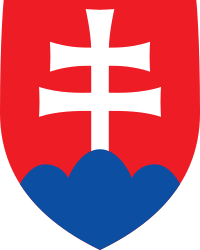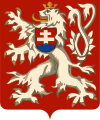|
Coat of arms of Slovakia
The coat of arms of the Slovak Republic consists of a red (gules) shield, in early Gothic style, charged with a silver (argent) double cross standing on the middle peak of a dark blue mountain consisting of three peaks. Extremities of the cross are amplified, and its ends are concaved. The double cross is a symbol of its Christian faith and the hills represent three symbolic mountain ranges: Tatra, Fatra (made up of the Veľká Fatra and Malá Fatra ranges), and Matra (in Hungary). The genesis and history of the iconography and symbolism of the state emblem of the Slovak Republic has three basic development periods and all three organically follow each other: Byzantine (6th-12th centuries), Hungarian (12th-20th centuries) and Slovak (19th-20th centuries).[1] Modern design historyIn 1990, the Slovak Interior Ministry tasked Ladislav Čisárik (a painter and heraldic artist) and Ladislav Vrtel (an expert in heraldry) with creating a new coat of arms and national flag in the aftermath of the Velvet Revolution.[2][3][4] Čisárik and Vrtel based their designs for a modern coat of arms and flag on an existing 14th century Hungarian coat of arms,[2][3] it was based on the seal of King Louis I of Hungary.[5][6] However, Čisárik and Vrtel chose to enlarge the hills three times to emphasize it as a national symbol. In addition to the national coat of arms and the national flag, the duo also designed a new presidential standard, which incorporates the same design as well.[2][3] Double crossOne of the modern interpretations of the double cross is that it represents Slovakia as an heir and guardian of Christian tradition.[7]  In Slovakia, there is a coded myth that the double cross was brought to the region by St. Cyril and St. Methodius, two missionaries from the Byzantine Empire. This legend, which is generally accepted today, arose only in the period of romanticism, accompanying the process of national awareness of the Slovaks in the middle of 19th century. So far, no archaeological finds have confirmed the presence of a double cross in Central Europe during the Great Moravian period or the immediately following period. The oldest double cross in present-day Slovakia dates back to the 11th century. Morover the exception of depictions on Byzantine coins, the double cross did not appear anywhere in mural iconography, in plastic form, or as a solitary object before the middle of the 10th century. According to Slovak archeologist Titus Kolník, the double cross legend of Cyril and Methodius is a fiction: "that myths have more power than history".[1] There are also attempts to validate the legend of the double cross associated with Cyril and Methodius, as well as to explore its potential mediating role through the supposed appearance of the double cross on early coins from the Hungarian royal Árpad dynasty (King Saint Stephen of Hungary (997–1038), King Béla I of Hungary (1060–1063)) to the depiction of the real double cross on the coins of King Béla III of Hungary (1172–1196)). The merging of the "cross" from the central field with the division sign - with the real cross in the colophon of the coin is completely accidental and cannot be considered a double cross. That is an iconographic misunderstanding, a simple misinterpretation of two normal crosses.[1][8] The double cross, a symbol of royal power, appeared only during the reign of King Béla III of Hungary (1172–1196).[9][1] Daughter of King Saint Ladislaus I Hungary, Saint Irene was a Byzantine empress, she was the mother of the Byzantine Emperor Manuel I Komnenos. The second son of King Géza II of Hungary, Béla arrived in Constantinople in 1163. Béla was raised in the imperial court of Manuel due to the close Byzantine-Hungarian relations of the mid-12th century, and he was even the heir to the throne. He had ambitions to create a Hungarian–Byzantine personal union.[1] In 1169, Manuel's young wife gave birth to a son, thus depriving Béla of his status as heir of the Byzantine throne. The most intensive contacts between the Hungarian royal court and the Constantinople imperial court was under Béla III.[1] It was during this time that Béla III brought with him the double cross as a royal emblem, which appeared for the first time on his coat of arms and minted coins.[9][1]  On the coins and seals of King Béla IV of Hungary (1235–1270), the double-cross shield reappears.[10]  After the extinction of the male branch of the Árpád dynasty in 1301, the Hungarian Anjou kings (King Charles I of Hungary (1308–1342), King Louis I of Hungary (1342–1382)) combined the Árpád dynasty's striped shield with their own lily coat of arms. By using the striped shield, the Anjous indicated their connection to the Árpád dynasty through a female line. On the reverse side of their seal, they engraved the double cross, which symbolized the Kingdom of Hungary.[11] Since 1526, when the Habsburgs became kings of the Kingdom of Hungary, the current "combined" coat of arms of Hungary including the double cross symbol and the stripes symbol was used as the symbol of the Kingdom of Hungary (except that the small crown below the double cross was added only in the 17th century). Three hillsThe triple peak represents the three mountain ranges Tatra, Matra and Fatra which symbolized the northern mountainous part of the Kingdom of Hungary. (The Tatra and the Fatra ranges are in present day Slovakia.) This interpretation is probably the oldest and most frequent one – it can be traced back to the 16th century, but stems probably from the 15th century. According to István Werbőczy's "Tripartitum" from 16th century, the heaps represent the mountains in this order. The three mountains below the double cross were used by King Ladislaus (1301–1305), who was crowned king of Hungary, but was a Czech from the house of the Přemyslids. Symbol of the SlovaksOrigins and coloursNot later than in the 16th century, the Slovaks started viewing the double cross also as a symbol of their nation.[7] This fact manifested itself during the Revolution of 1848/1849, Slovaks were fighting along with the Austrians against the Hungarians (though many Slovaks chose to defend the Hungarian case). A "Slovak National Council" was established for this purpose in August 1848 in Vienna. The present-day coat of arms was used on the seal of this Slovak National Council for the first time officially as the national symbol of the Slovaks (instead of being the official symbol of Upper Hungary only). From that time onwards, the symbol has been used very frequently. As for the colors, the colors are supposed to be the three "Slavic" colors red-white-blue (Slavic tricolor). Since the Upper Hungary coat of arms was already part of the coat of arms of the Kingdom of Hungary at that time, only the color of the three mountains had to be changed (it happened on the Slovak flag for the first time) from green to "blue" to receive the red-white-blue combination. As for the origin of the red color (in the Slovak and in the Hungarian coat of arms), the coat of arms has often had the red color as an almost inseparable attendant of the double cross in the coats of many Hungarian and Slovak towns since the Middle Ages. Also, the coat of arms of Béla III. is thought to have had red background. In general, red background color was used frequently for coats of arms in the late 12th and early 13th century in central Europe. One of the modern interpretations of the color is that it represents the bloody lining and symbolizes the Slovak 'martyrdom' during the time of Magyarisation (19th century).[citation needed] The color of the three mountains was originally green but in 1848 the Slovak National Council used it as blue in accordance with the Slavic tricolor. 20th centuryIn 1918, Czechoslovak troops began occupying northern Hungary in accordance with the territorial promises that the Triple Entente made to Czechoslovak politicians during World War I. However, Slovakia (Upper Hungary) was occupied by Hungarian troops from the Hungarian Soviet Republic, who set up the Slovak Soviet Republic as a puppet regime. Its emblem was the red star, a symbol of communism. Following a brief war between Hungary, Czechoslovakia and Romania, Slovakia was incorporated into Czechoslovakia. In 1920 the Slovak coat of arms became part of the state coat of arms of Czechoslovakia. Between 1939 and 1945, it was the state symbol of the First Slovak Republic. In 1945, it became part of Czechoslovakia's coat of arms again. From 1960 to 1990 the symbol was officially forbidden, because it was interpreted by the Communists as the symbol of the fascist Slovak State. The old coat of arms was replaced in the Czechoslovak coat of arms by an artificial symbol consisting of Mt. Kriváň and three flames. The three flames were supposed to symbolize the Slovak National Uprising of 1944. On 1 March 1990, after the Velvet Revolution, the old coat of arms became the official symbol of the "Slovak Republic", which was still part of Czechoslovakia. Based on the Constitution of the Slovak Republic of September 3, 1992, the same coat of arms became the symbol of independent Slovakia, which arose on January 1, 1993. A law of February 18, 1993, precised the details of the coat of arms: for example, though not explicitly defined in the coat's blazon in the past, during the World War II era the cross mostly used to be depicted with convex endings of the stake and the bars; therefore the new description clearly reads to depict them as concave. The coat of arms is used by the Slovak Air Force as its roundel. Since 1992 the coat of arms is also placed on the Slovak flag. Photo gallery
Historical coat of arms
See also
References
External links |
||||||||||||||||||||||




















